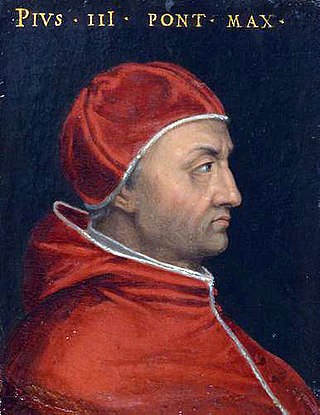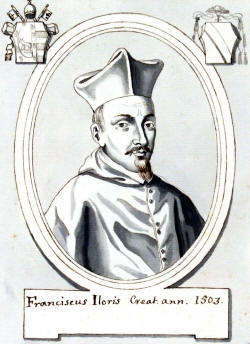The Borgias, also known as the Borjas, were a European papal family of Spanish origin that became prominent during the Renaissance. The family produced three popes of the Catholic Church:

Cesare Borgia was an Italian cardinal and condottiero, an illegitimate son of Pope Alexander VI and member of the Spanish-Aragonese House of Borgia. His fight for power was a major inspiration for The Prince by Niccolò Machiavelli.

Pope Alexander VI was head of the Catholic Church and ruler of the Papal States from 11 August 1492 until his death in 1503. Born into the prominent Borgia family in Xàtiva in the Kingdom of Valencia under the Crown of Aragon, Spain, Rodrigo studied law at the University of Bologna. He was ordained deacon and made a cardinal in 1456 after the election of his uncle as Pope Callixtus III, and a year later he became vice-chancellor of the Catholic Church. He proceeded to serve in the Curia under the next four popes, acquiring significant influence and wealth in the process. In 1492, Rodrigo was elected pope, taking the name Alexander VI.

Pope Pius III, born Francesco Todeschini, was head of the Catholic Church and ruler of the Papal States from 22 September 1503 to his death. At just twenty-six days, he had one of the shortest pontificates in papal history.

Pope Callixtus III, born Alfonso de Borgia, was head of the Catholic Church and ruler of the Papal States from 8 April 1455 to his death, in August 1458.

The House of Borgia was a Spanish noble family, which rose to prominence during the Italian Renaissance. They were from Xàtiva, Kingdom of Valencia, the surname being a toponymic from the town of Borja, then in the Crown of Aragon, in Spain.
Papal coats of arms are the personal coat of arms of popes of the Catholic Church. These have been a tradition since the Late Middle Ages, and has displayed his own, initially that of his family, and thus not unique to himself alone, but in some cases composed by him with symbols referring to his past or his aspirations. This personal coat of arms coexists with that of the Holy See.
Duke of Camerino is a title of nobility, originally in Papal peerage. It was created on 1503 by Apostolic authority of Pope Alexander VI and cardinal council over the ancient Marquissate of Camerino, which was part of the Dukedom of Spoleto.

The Archdiocese of Valencia is a Latin Church diocese of the Catholic Church located in north-eastern Spain, in the province of Valencia, part of the autonomous community of Valencia. The archdiocese heads the ecclesiastical province of Valencia, with authority over the suffragan dioceses of Ibiza, Majorca, Minorca, Orihuela-Alicante and Segorbe-Castellón. The archbishops are seated in Valencia Cathedral. Enrique Benavent Vidal succeeded Cardinal Antonio Cañizares Llovera as the Archbishop of Valencia in 2022.

The Renaissance Papacy was a period of papal history between the Western Schism and the Reformation. From the election of Pope Martin V of the Council of Constance in 1417 to the Reformation in the 16th century, Western Christianity was largely free from schism as well as significant disputed papal claimants. There were many important divisions over the direction of the religion, but these were resolved through the then-settled procedures of the papal conclave.
Pedro Luis de Borja, Duke of Spoleto and Marquess of Civitavecchia was the younger brother of Rodrigo Cardinal Borgia, who in 1492 became Pope Alexander VI, and nephew of Alonso Cardinal de Borja, who in 1455 became Pope Callixtus III. He was called Don Pedro Luis.

The 1458 papal conclave, convened after the death of Pope Callixtus III, elected as his successor Cardinal Enea Silvio Piccolomini who took the name Pius II.

Gaspar de Borja y Velasco was a Spanish cardinal, ecclesiastic and politician. He belonged to the house of Borgia and served as Primate of Spain, Archbishop of Seville, Archbishop of Toledo and viceroy of Naples. He was the great-great-great-great-grandson of Pope Alexander VI.

Louise Borgia was a French noblewoman. She was the daughter of Cesare Borgia, Duke of Valentinois, who died when she was almost seven years old. She was also Dame de Chalus, a title she inherited from her mother Charlotte of Albret. She was a member of the Third Order of Saint Dominic.

Pope Callixtus III created nine cardinals in two consistories.

Francisco Galcerán de Lloris y de Borja, Catalan: Francisc de Lloris i de Borja Italian: Francesco Borgia, was an unconsecrated cardinal of the Catholic Church, and a member of the Borgia family.
Juan de Borja Lanzol de Romaní the Younger (1470–1500) was a Spanish Roman Catholic bishop and cardinal.
Juan Domingo de Borja y Doncel was the father of Pope Callixtus III. He held the title over the Barony La Torre de Canals. He was a member of the House of Borja. He was born in the Spanish village of the same name, Borja.
Jofré Llançol i Escrivà,, also known as Jofré de Borja y Escrivà and Jofré de Borja y Doms, was a Spanish noble from Xàtiva, Kingdom of Valencia. He was related by marriage to the Borgia family. He was an uncle of Cardinal Luis Juan del Milà and the father of Pope Alexander VI.

Juan Castellar y de Borja (1441–1505) was a Spanish Roman Catholic bishop and cardinal.

The Route of the Borgias is a cultural route, that includes sites associated with the Borja or Borgia, located in their native Valencian Community, Spain. The marketing of the route was inaugurated in 2007.